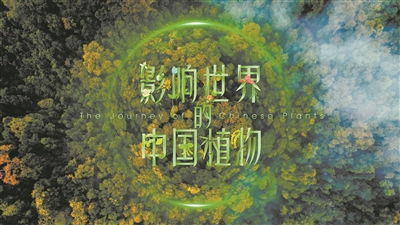
Photo courtesy of interviewees on the poster of "Chinese Plants Influencing the World"
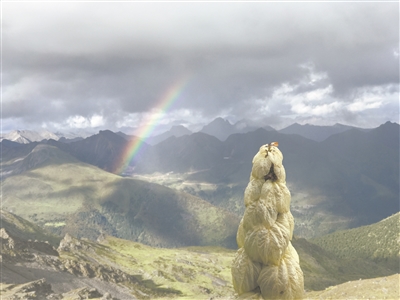
Pagoda under the Rainbow photo by Hu Kunchi
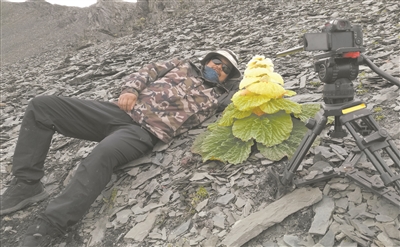
Hu Kunchi and Ta Huang took a photo courtesy of the interviewee
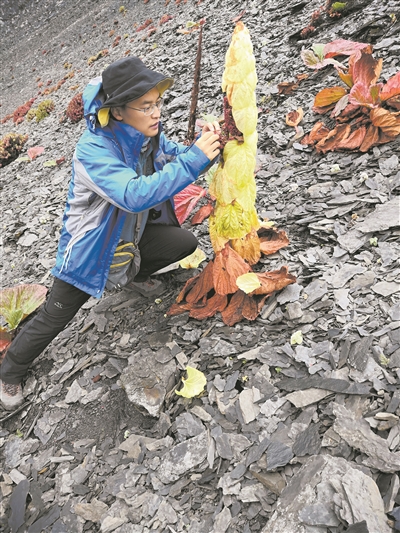
Photo courtesy of Song Bo's interviewees in the research tower
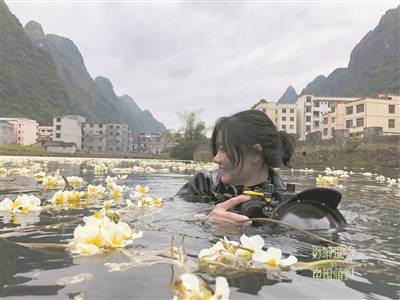
Photo provided by interviewee Zhou Ye photographing sea cauliflower in Guangxi
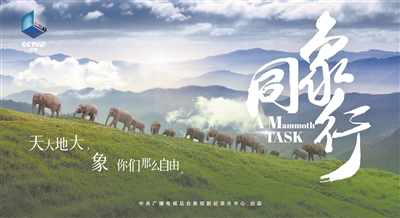
Photo courtesy of interviewees on the poster of "Walk with Elephants"
The rapid development of science and technology in China has provided a strong support for the development of scientific documentaries, both in terms of content and technical means. What is needed now is for more people who are interested in this to join in and create more high-quality products, so that science can be vividly presented and flowed in documentaries, integrated into people's way of thinking, and shaped the scientific spirit of the nation.
Strong ultraviolet rays, severe cold, and strong winds. In the southeast of the Qinghai-Tibet Plateau, on the barren land, sharp-edged flowstones are piled up together.
Hu Kunchi was lying sideways on the pile of rocks wearing sunglasses, his spirits were high. Beside him is a yellow plant called Tahuang, which is growing wantonly. Finding it and documenting it took Hu Kunchi's team several months.
Many such searches and waiting have made "Chinese Plants Influencing the World", which is hailed as comparable to the BBC documentary. Hu Kunchi is the director of the first episode of the documentary Materia Medica.
This is China's first plant documentary. Since it was broadcast, even strict Douban netizens have given it a high score of 8.5.
"Let science flow vividly in the documentary and integrate it into our way of thinking and national character." Li Chengcai, chief director of "Chinese Plants Influencing the World", said that this is his original intention for making scientific documentaries.
That's really what science documentaries are about.
In the 1980s, the documentary "Cosmos" produced by the famous American astronomer and popular science writer Carl Sagan has gained hundreds of millions of viewers around the world. More than 30 years later, American astrophysicist Neil Tyson made a documentary tribute to Cosmos. He said that the reason why he became a scientist was because he watched Carl Sagan's "Cosmos" when he was a child.
Domestic scientific documentaries represented by excellent works such as "Chinese Plants Influencing the World" are also advancing in exploration.
Long time investment: it took three years to make the documentary, half of which was spent on study and research
Ta Huang often brought tears to Li Chengcai's eyes.
This kind of plant is very rare. It stands alone in the desolation and blooms only once in its life.
But how to tell the story of Ta Huang well? From bud to bloom, from reproduction to death, what life stages has it gone through? Why does it only bloom once in its life? How does it work with its "friend" tardigrade?
These are the questions that the creative team of "Chinese Plants Influencing the World" want to answer, and their biggest difficulty is the barrier of botanical knowledge.
"The accumulation of knowledge in a blank field is inseparable from the accumulation of time." Zhou Ye, another chief director of "Chinese Plants Influencing the World", said.
Most of the documentary production team members are from film and television majors. During the three years of making the documentary, they spent nearly half of their time studying and researching. They not only need to be familiar with the natural attributes of related plants, but also need to understand the humanistic characteristics and historical background of plants.
In 2018, Hu Kunchi and his team went to Shangri-La to "visit" Tahuang on the spot.
In previous years, within dozens of days in early summer, Tahuang would quickly grow giant tidbits of 1.5 meters to 2 meters. Through the accumulation of early learning, the team members have long remembered the appearance of Tahuang, but when they actually climbed to the Liushi Beach, one day, two days... six days passed, and everyone still couldn't find the figure of Tahuang's flower bud.
Hu Kunchi wanted to ask Song Bo, the team's scientific advisor and associate researcher at the Kunming Institute of Botany, Chinese Academy of Sciences, for help, but there was no signal on Liushi Beach, and pictures of "suspected" Tahuang could not be sent out.
After going down the mountain, Hu Kunchi contacted Song Bo. The Tahuang expert made a special trip from Kunming to Shangri-La, and went to Liushitan with the creative team. Finally, Song Bo revealed the mystery for the team. It turned out that this year, Tahuang blossomed nearly half a month later than in previous years. Because there are other shooting tasks in the later stage, if you wait, you will miss the flowering period of the next plant. But the journey has not been fruitless. Hu Kunchi's team became familiar with the topography, established a closer relationship with Song Bo, and met many local villagers. In the spring of the second year, Hu Kunchi would ask the villagers and Song Bo about the flowering of Tahuang almost every day.
In 2019, Hu Kunchi and his creative team seized the opportunity to cross one mountain after another, bypass one mani pile after another, and finally found a budding Tahuang plant.
"Everyone was very excited, and they all lay on the ground and took photos with Ta Huang." Hu Kunchi said.
"Chinese Plants Influencing the World" tells the story of Ta Huang for 10 minutes, but the filming took nearly two months. During this process, the accumulation of time became the key again.
The flowering season of Tahuang is from June to July, which coincides with the local rainy season.
The tardy-eyed fungus that helps Tahuang pollinate is another protagonist in Tahuang's story. Whenever it rains, tardigrades either remain motionless or fly away, and filming is interrupted. The team members could only put on their raincoats, silently, and wait for the sky to clear together. "We depend on the sky, and the shooting of scientific documentaries is full of uncertainties." Hu Kunchi said with a smile.
Hu Kunchi was deeply impressed by the Ta Huang under the hail. "The Tahuang plant is not straight, but has some twists. It looks like a girl in a skirt in the hail, looking into the distance. That is the shot I am most satisfied with." Hu Kunchi said.
Participation of scientific talents: the ecological construction of scientific images requires the participation of scientists
The audience gave very high praise to "Chinese Plants Influencing the World".
"EH Wilson, a famous British botanist, said, 'In any place in the temperate zone of the northern hemisphere, there is no garden tree species that does not originate from China.' I used to doubt it until I watched this documentary: "Influence Chinese Plants of the World." Some viewers commented.
But it must be admitted that we still lack more such excellent science documentaries.
As early as 1957, the British Broadcasting Corporation (BBC) established the Museum Department in Bristol, which started the production of scientific documentaries. In 1964, BBC Two began broadcasting the TV science documentary "Horizon" series, which is the longest-running TV science documentary series of the BBC and has become an international standard for measuring the quality of scientific documentaries.
Statistics show that in 2001, driven by the transformation of science and education films, my country's earliest science documentary column "Discovery Journey" was born. Experts in the industry believe that as of now, the development of science documentaries in my country is still in its infancy, the scale is small, and the scale effect has not yet been formed, and the production capacity, dissemination capacity and industrial development capacity are still weak.
In Li Chengcai's view, the low scientific literacy of film and television personnel is the main reason for this phenomenon.
Li Chengcai and Zhou Ye have worked together to complete many famous documentaries including "Wall Street" and "Currency", but filming "Chinese Plants Influencing the World" is a new and more difficult task for these two excellent directors. Trying it also caused them a lot of thinking.
""Chinese Plants Influencing the World" has more than 100 photographers. They are brave and passionate, but they don't have the knowledge of botany and genetics." Li Chengcai said.
In countries where scientific documentaries are relatively developed such as Britain and the United States, a scientific documentary, from the producer to the host to the photographer, often has certain scientific knowledge. Take BBC Studios, which has always been a benchmark in the field of scientific documentaries, as an example. In order to ensure the scientific nature of documentaries, the "scientist team + filmmaker team" is the basic configuration, and even the director or producer himself is an expert in a certain scientific research field.
The reserve of scientific knowledge can help producers and directors find key nodes in scientific stories, make documentaries more fascinating, and enable photographers to achieve richer and more precise image expressions.
Li Jinwei, chief director of the three phenomenal scientific documentaries "My Newton Coach", "Mendeleev Is Busy", and "The Man Chosen by Mathematics", analyzed that the threshold for creating scientific documentaries is relatively high, and there is not enough learning enthusiasm and learning ability. Without enough enthusiasm to communicate and share scientific knowledge to the audience in an interesting way, it is difficult to do this type of film well.
"The low scientific literacy of film and television personnel is caused by many factors." Li Chengcai said, "It takes time to change, and at present we can only rely on accumulation."
In addition, the participation of scientists is crucial.
According to Zhou Ye, in "Chinese Plants Influencing the World", there are more than 100 expert consultants. From the selection of plants to the explanation of natural attributes, from the joint investigation of the shooting location to the detailed check of the script, their participation is extensive and in-depth.
Huang Hongwen, the chief scientific advisor of the documentary and director of the Lushan Botanical Garden of the Chinese Academy of Sciences, believes that the first episode of "Chinese Plants Influencing the World" is a "big basket" that contains the content of the next few episodes, which is very important. For this reason, Huang Hongwen and Zhou Ye revised the script word by word several times.
Huang Hongwen also went to the depths of the jungle in the Yangtze River Basin with the photography team. The 62-year-old scholar who had studied kiwi fruit all his life followed in the footsteps of EH Wilson, the British "plant hunter", and told the adventure of kiwi fruit coming out of Yichang Dalaoling more than 100 years ago.
Tahuang expert Song Bo also participated deeply in the filming work as a guide and teacher.
Which Tahuang plant may bloom this year, when tardigrade fungus began to pollinate, how did tardigrade and Tahuang cooperate... Song Bo is willing to answer these questions, and he prefers to call his "teaching" For "storytelling".
In Song Bo's view, scientific researchers need to use storytelling to let the documentary creation team understand the logic behind plant knowledge.
During the filming of Ta Huang, Song Bo had other experimental work in Kunming. In order to shoot, he needs to travel back and forth between Kunming and Shangri-La. "This documentary can let the public know about our work, and it can also play an important role in disseminating scientific knowledge. Although I have spent some time and energy, I am still very happy to participate in it." Song Bo said.
Li Chengcai said that the scientific consultants invited by "Chinese Plants Influencing the World" have a high enthusiasm for popularizing science, and the cooperation between the two parties is happy and smooth. However, overall, the number of domestic scientists involved in popular science film and television creation is still very limited.
"Some scientists have their own jobs and don't want to pay attention to the production of documentaries. I can understand, but the ecological construction of scientific images requires the participation of scientists." Li Chengcai said.
The embarrassment of return on investment: the high cost of shooting and the long cycle make the production team daunting
In addition to having high scientific literacy, the high cost and long cycle of shooting scientific documentaries also make many production teams daunted.
Zhang Tongdao, director of the Documentary Center of Beijing Normal University, said in an interview with Science and Technology Daily that the basic cost of a 50-minute video of the British scientific documentary series "Planet" is about 10 million yuan. Although the amount of domestic investment is not as high as that of foreign countries, the investment for a complete production of a scientific documentary can start at tens of millions. With an investment amount of tens of millions and an annual investment of time, it is still difficult to obtain matching attention and market returns in China.
The investment of "Chinese Plants Influencing the World" comes from the Beijing Expo, with a total investment of about 30 million yuan. The main revenue comes from the sharing of broadcasting platforms and the sale of material usage rights.
"These revenues are negligible compared to the cost of documentary production." Zhou Ye said, "Currently documentaries are difficult to achieve cost recovery, unless soft broadcasting is embedded in documentaries, but this is not in line with our imagination of documentaries."
According to Zhang Tongdao, like "Chinese Plants Influencing the World", more than half of the investors of various types of documentaries in China come from TV stations and government agencies at all levels.
Science documentary is an activity with public attributes. The active promotion of the government and relevant departments, associations, and institutions is an important reason for the rapid development of science popularization film and television in my country in recent years. But this government-led, less commercial model is both an advantage and a weakness.
"Main investors often have weak business attributes and pay more attention to science popularization and influence. However, the creative team, broadcast unit and brand operation belong to different units and teams, and it is difficult to form a joint force of communication." Zhang Tongdao said.
For the broadcasting platform, whether it is a TV channel or an online platform, the main source of income is advertising. This has led many platforms to choose entertainment or film and television programs with high traffic volumes. Science documentaries have limited space and traffic, and are marginalized and weak in communication. Coupled with the prevalence of pirated resources, the situation of science documentaries has become even more difficult.
"At present, the domestic documentary field has not yet formed a basic model of return on investment and market circulation, nor has it formed a stable industrial model." Tongdao Zhang said.
Efforts towards high level: Mobilizing various forces to jointly promote the development of scientific documentaries
Regardless, change is happening.
The first is the effort from the science documentary production team.
In recent years, from "Chinese Plants Influencing the World" to "Azure Realm", from "Legend of the Chief Teacher" to "Two Hundred Years of Surgery", with the development of science and technology, domestic scientific documentaries have continued to explore and innovate in themes and forms , a batch of fine products emerged.
Producer Liu Ying is an explorer. The most successful attempts of her and her team are "Walk with the Elephant", "Fly Chang'e" and "Hi Mars".
Relying on the long-term accumulated production and production advantages, Liu Ying and her team tried to find a relatively in-depth cut from news hotspots in a short period of time, and created short scientific documentaries under hot topics.
"The dissemination effects of these three short documentaries are very good. We have tried to carry out a series of developments in the direction of integrated media, especially "Traveling with Elephants". From documentary short films, popular science short videos to poster production, a multi-level integration has been formed. The form of media communication." Liu Ying said.
The rapid development of science and technology in China has provided a strong support for the development of scientific documentaries, both in terms of content and technical means. What is needed now is more people who are interested in this and create more high-quality goods.
The second step in the development of scientific documentaries is the establishment of market models and industrial models.
The development of the industry is inseparable from the power of the market, and the logic of the market is also needed for scientific documentaries to overcome many obstacles.
Stones from other hills, can learn. Both Zhang Tongdao and Lu Lu, director of Peking University's audio-visual communication research center, believe that the development of the American Discovery Group has certain reference value. At present, Discovery Group has formed a complete coordination mechanism of production, distribution, communication and brand operation, and has broadcast platforms in more than 200 countries and regions around the world. Through the three-pronged profit model of subscriber fees, advertising revenue, and program resale, Discovery Group's annual revenue is more than 10 billion US dollars.
"Discovery Channel's documentaries follow the logic of the market, pay attention to the preferences of the audience, and emphasize the combination of entertainment and knowledge." Lu said, "The huge profits allow Discovery to invest in the reproduction of programs to form high-quality programs. A virtuous circle of production.”
In Zhang Tongdao's view, to establish a domestic market model and an industrial model for scientific documentaries, the first thing to do is to get through the mechanism. "The documentary team is no longer just a production department, but needs a team responsible for production, a team responsible for dissemination, and a team responsible for brand building. The awareness of this kind of business operation should be formed from the early stage of documentary creation." Tongdao Zhang said.
Publicity and commercial communication go hand in hand, and the common goal is to maximize the effect of scientific communication.
"Although science documentaries do not have a wider audience than food documentaries, science documentaries are naturally intricate and ups and downs. In the future, more interesting topics, better narrative modes, and a more mature business environment will jointly promote this. The development of documentary genres." Documentary director Bao Yonghong said.
Finally, the future of scientific documentaries requires the participation of the whole society.
The "Opinions on Further Strengthening the Popularization of Science and Technology in the New Era" issued by the General Office of the Central Committee of the Communist Party of China and the General Office of the State Council proposed that it is necessary to establish a concept of large-scale science popularization and build a socialized science popularization development pattern that is jointly promoted by the government, society, and the market.
"The requirements for the construction of a large science popularization pattern are not only in terms of organizational form, but also in terms of strengthening the sense of responsibility of the whole society's science popularization work, linking various units, working together, and synergizing efforts." Yin Chuanhong, vice chairman of the China Science Popularization Writers Association Say.
Mobilizing various forces to jointly promote the development of scientific documentaries is also Li Chengcai's long-term hope.
He mentioned the "World Science and Documentary Congress" many times in his speeches. Every year, this conference convenes groups of managers and scientists from all major media sciences around the world to jointly plan the development direction of the world's future science films.
Li Chengcai is promoting the establishment of a Chinese version of the "World Science and Documentary Congress". "It is not difficult to invite film and television workers and scientists to participate, and more importantly, to find willing entrepreneurs and directors of the documentary broadcasting platform." Image protection mechanism."
"This is a valuable and meaningful thing. If we can build this platform, it will be the best destination for money." Li Chengcai said.
"The first step in science popularization and science dissemination is to let the public understand and appreciate science, and then let the public participate in and apply science. Further, if we can spread reason and explore rationality, let the public gain knowledge and increase wisdom. At the same time, gain the fun of thinking and the enjoyment of the mind, then the communication efficiency we expect can undoubtedly be better achieved.” Yin Chuanhong said, “Currently, there are still rare scientific documentaries, which just have a broader scientific vision and are more flexible. There is room for expansion. I look forward to more excellent directors in the new era, who will raise our science documentaries to a 'high-end' level as soon as possible."










Comments